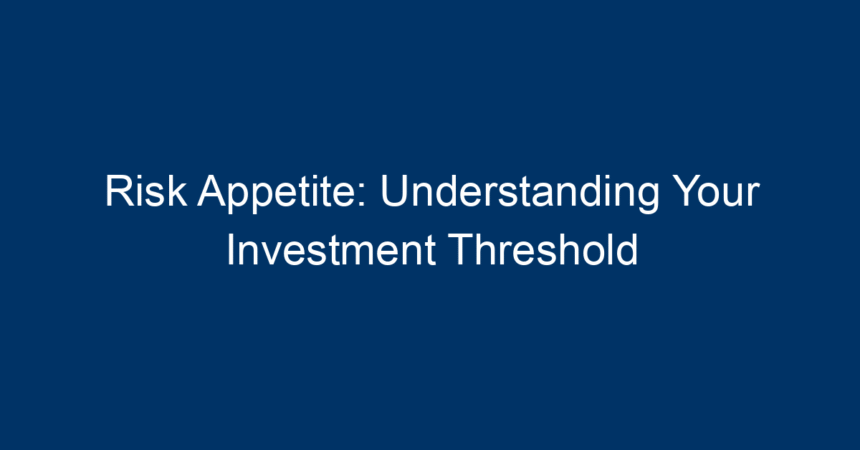In the ever-evolving world of finance and investing, one term consistently rises to the forefront: risk appetite. Understanding your risk appetite is pivotal to navigating the turbulent waters of investing. It sets the stage for your investment strategy, informs your decisions, and ultimately dictates your financial success. In this article, we will explore what risk appetite is, how to assess your own, and how to align it with your investment goals.
What is Risk Appetite?
Risk appetite refers to the amount of risk an individual or institution is willing to take on in pursuit of their financial goals. It encompasses not just the willingness to accept fluctuations in investment value, but also the potential for loss. High risk appetite investors are usually more tolerant of volatility, often seeking higher-reward opportunities. Conversely, those with a low risk appetite prefer stability and may prioritize capital preservation over quick gains.
The Components of Risk Appetite
Understanding risk appetite involves analyzing several key components:
-
Financial Situation: Your current financial standing, including income stability, savings, and debts, plays a crucial role in determining your risk appetite. A secure financial foundation allows for more aggressive investment strategies.
-
Investment Goals: Whether you are saving for retirement, a house, or your child’s education will heavily influence your risk tolerance. Short-term goals may require a conservative approach, while long-term objectives may allow for greater risk.
-
Time Horizon: The length of time over which you plan to invest is vital. Generally, a longer time horizon allows for more aggressive investment strategies, while a shorter term may necessitate caution.
- Emotional Resilience: Psychology plays a major role in how individuals respond to market fluctuations. Someone who is emotionally affected by losses may have a lower risk appetite, while a more rational investor might be willing to endure short-term volatility.
Why is Assessing Your Risk Appetite Important?
Assessing your risk appetite is crucial for several reasons:
-
Informed Decisions: Knowing your risk appetite helps you choose appropriate investment vehicles, whether they be stocks, bonds, or mutual funds.
-
Reduced Anxiety: Aligning your investments with your risk tolerance minimizes stress during market downturns, allowing for a more comfortable investing experience.
- Long-term Strategy: A clear understanding of your risk appetite enables you to craft a coherent long-term investment strategy, aiding in achieving financial objectives.
How to Assess Your Risk Appetite
1. Self-Assessment Questionnaire
One of the most effective ways to determine your risk appetite is through self-assessment questionnaires. These questionnaires utilize various scenarios and questions to gauge your comfort level with risk.
Sample Questions:
- How would you feel if your investment dropped 20% in one month?
- How important is capital preservation to you?
- Are you comfortable with the idea of losing a portion of your principal investment?
2. Consult a Financial Advisor
While self-assessment is helpful, consulting a financial advisor can provide a more nuanced understanding of your risk appetite. Advisors can offer tailored assessments and recommend investment strategies that align with your financial goals and risk tolerance.
3. Analyze Historical Performance
Examining the historical performance of various investment vehicles can also help clarify your risk appetite. By assessing how different assets performed during various market conditions, you can better understand your own comfort with potential risks.
Match Your Risk Appetite with Investment Strategies
Once you’ve assessed your risk appetite, the next step is to align it with suitable investment strategies.
Conservative Investment Strategies
If your risk appetite is on the lower end, consider the following options:
- Bonds: Government and corporate bonds are generally less volatile than stocks, providing stability.
- Dividend-Paying Stocks: Established companies that pay dividends tend to be safer and offer regular income.
- Cash or Cash Equivalents: High-yield savings accounts and money market funds are ideal for those who want minimal risk.
Moderate Investment Strategies
For those with a medium risk appetite, a balanced approach may be ideal:
- Balanced Mutual Funds: These funds typically invest in a mix of stocks and bonds, offering both growth and income.
- Index Funds: Investing in index funds provides diversification while maintaining lower fees than actively managed funds.
- Exchange-Traded Funds (ETFs): These offer exposure to various sectors while allowing for liquidity and flexibility in trading.
Aggressive Investment Strategies
If you have a high risk appetite, consider strategies that capitalize on higher reward potential:
- Growth Stocks: Companies that demonstrate strong growth potential often pose higher risks but offer substantial returns.
- Technology and Start-up Investments: Investing in innovative firms may yield significant financial rewards, albeit with greater risk.
- Cryptocurrency: The volatile nature of cryptocurrencies can yield incredible gains for those who are willing to accept high risk.
Understanding Market Conditions and Their Impact on Risk Appetite
Market conditions can significantly influence individual risk appetites. For example, during periods of economic downturn, even the most seasoned investors may become skittish. Conversely, a bullish market can lead to more aggressive investment behaviors.
Staying Informed
Keeping abreast of market trends and economic indicators can help investors understand when to adjust their risk appetite. Tools like financial news outlets, economic reports, and investment seminars can provide valuable insights.
Adaptability
Your risk appetite is not static; it can evolve based on your life circumstances, financial goals, and market conditions. Regularly reassessing your risk tolerance in light of changes in personal finances or economic situations is crucial to maintaining a sound investment strategy.
Actionable Insights
In conclusion, understanding your risk appetite is a foundational aspect of successful investing. Here are some actionable insights to help you along the way:
-
Conduct Regular Assessments: Reevaluate your risk appetite at least once a year or after major life events.
-
Stay Informed: Keep yourself updated on market fluctuations and economic trends to make informed decisions.
-
Diversify Your Portfolio: Regardless of your risk appetite, ensure your investments are diversified to mitigate risks.
-
Consult Professionals: Consider hiring a financial advisor for personalized advice tailored to your unique risk tolerance.
- Embrace a Long-Term Perspective: Focus on long-term financial goals rather than short-term market fluctuations.
By effectively understanding and applying your risk appetite in investments, you can foster a more confident and strategic approach to your financial goals.
This knowledge will serve you well as you embark on your investment journey, allowing discovery and growth in the financial world with minimal anxiety.




